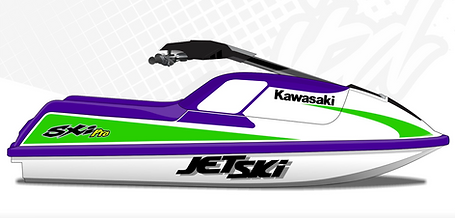
STANDUP JETSKI ARCHIVE
The first stand-up PWC, commonly known as a jet ski, was developed by Clayton Jacobson II in the late 1960's and early 1970s. The term 'JETSKI' was coined by Kawasaki and is still used today.
Jacobson, an inventor from California, created prototypes that were the precursor to the stand-up models popular today.
While early models were different from the modern versions, they revolutionized water sports, offering a unique experience that combined elements of surfing and motorized boating.

THE FIRST PROTOTYPE STAND UP JETSKI

One day on the way home after a minor crash on the racetrack, Jacobson found himself taking a break in an irrigation ditch to have a beer with a friend while picking the gravel out of his wounds and lamenting that there had to be a way to enjoy the exhilaration and excitement of a motorcycle without the inherent danger of falling onto hard ground at high speeds.

JACOBSON & PATENTS
A second prototype, built in 1966, caught the attention Bombardier. who at the time was a snow-mobile manufacturer. Bombardier prompted the licensing of Jacobson's patents for the sit-down version of his jet-propelled personal watercraft that would become the sea-doo in the future.
In all, Jacobson would eventually build 12 different stand-up prototypes.
Bombardier entered a licensing agreement with Jacobson for his sit-down personal watercraft patents in order to produce their first model of Sea-Doo, which was produced from 1968 to 1970.
Jacobson's agreement with Bombardier prevented him from entering into any other licensing agreement until 1971, at which point he entered into an exclusive agreement to license his patents and development on the stand-up models to Kawasaki.
By this point Jacobson was on his 7th prototype stand-up model.
Kawasaki introduced the first production stand-up Jet Ski in 1973.
In 1976 Kawasaki sent a letter of intent to end their agreement with Jacobson, which resulted in legal dispute and the loss of Kawasaki's licenses' exclusivity.
In 1986 Jacobson entered a decade-long contract with Yamaha Motor Company, signing as a consultant to their water vehicle division.
This agreement included royalties on Yamaha's Superjet.
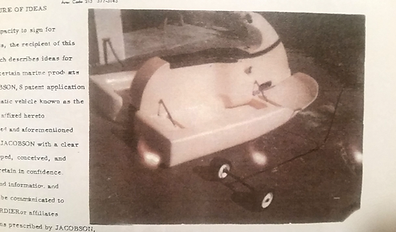
THE FIRST PROTOTYPE SITDOWN JETSKI

Kawasaki introduced the first production stand-up PWC in October 1972. These machines were powered by modified 400cc 2-stroke twin-cylinder engines.

1976-1982 KAWASAKI MODELS
The 1976 JS400 was popular among thrill-seeking recreational riders and racers. The 1977 JS440 offered more power and performance. It was one of Kawasaki's longest-selling models.
In 1982, Kawasaki introduced the JS550, which had better performance. The 550 featured a newly designed high-capacity mixed-flow pump, driven by a 531cc engine.
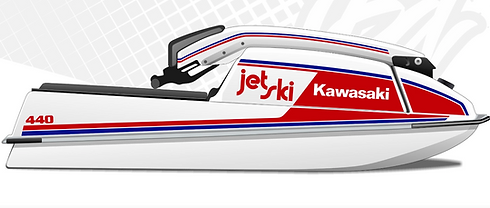


1982-1986 KAWASAKI MODELS
While the JS550 continued to be improved, in 1986, Kawasaki introduced the JS300. The JS300 was a single-cylinder 294cc two-stroke engine featuring automatic oil injection.
They also added the 650 X2, their first sit-down Jet Ski, and originator of the Sport Class for PWC racing.
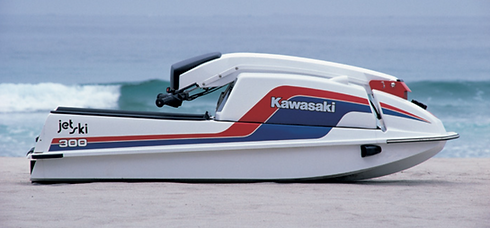
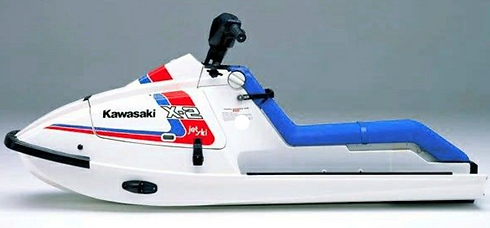

1987-1992 KAWASAKI MODELS
Kawasaki introduced the 650SX. It featured a higher capacity axial flow pump and a powerful 635cc two-stroke twin engine in a modified V-hull design for increased maneuverability and stability.
In 1992, the company introduced an even bigger motor and jetski called the 750SX. The engine was a twin-cylinder 743 cc two-stroke with reed valves. The redesigned hull was easier to turn and had better stability.



1995 KAWASAKI MODELS
The only model introduced in 1995 was the Kawasaki 750SXI PRO. The 750 SXI (JS750-B) became the first stand-up Jet Ski with dual carburetors. these models are hard to come by today.
